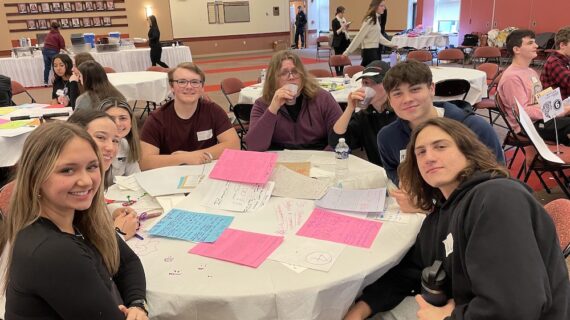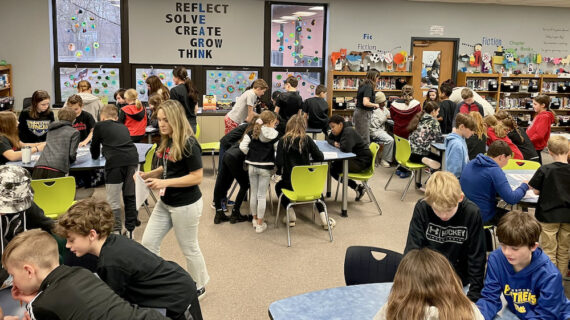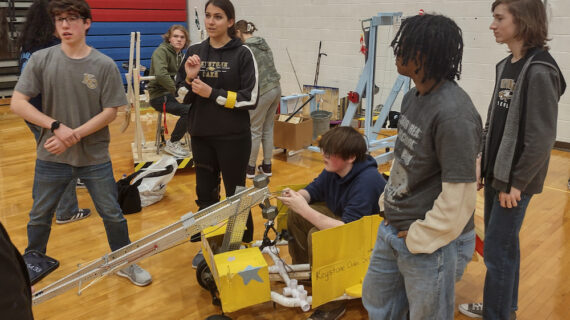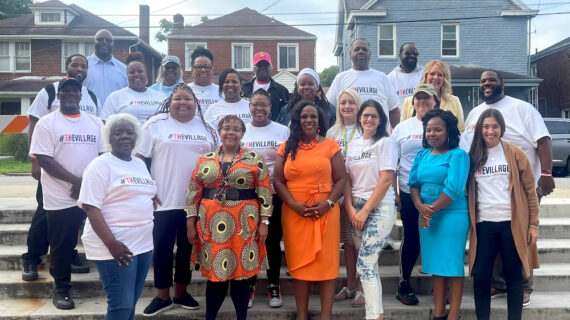
With mini-courses on just about everything, Jefferson-Morgan offers students an educational coat of many colors
This story is one in a series created in collaboration with the AASA Learning 2025 Alliance to celebrate the work of groundbreaking school districts in the Pittsburgh region. Kidsburgh will share these stories throughout 2024.
Remember the Whitman’s Sampler? You’d open the box and encounter all kinds of chocolate treats — different flavors, different textures, but all of them delicious.
That’s the creative approach that Jefferson-Morgan Middle/High School is taking with one corner of its curriculum: a slate of courses that the small, rural district in Greene County can’t offer as full classes but still wants students to benefit from.
At the school, students sign up for an astonishing range of subjects from mental health to cooking, volleyball to automotive maintenance, crocheting to personal finance. Change a tire. Listen to some vinyl. Go running at a school without a track team.
The result? Now Jefferson-Morgan’s students have the opportunity to grow into renaissance men and women in miniature, finding areas of interest they might not know they had.
It’s part of “personalized learning time,” which allows teachers to curate specific ideas they might want to share in a one-day or multi-day course — and allows students, too, to share their interests with peers and teachers.
“We’re a small school, so we have to be creative,” says Superintendent Brandon Robinson. “This is a way to teach multiple electives and mini-courses, and make sure our high school students can get a taste of everything.”
The program crackles with life as teachers share their passions and skills. Kids are finding doorways to careers and abilities they hadn’t considered. And — no small thing — the scheduling for the mini-courses is app-based, a wonderfully frictionless approach for a generation of kids surgically attached to their phones.
So far, the kids are all in.
“That break where they get more voice and choice,” Robinson says, “is something they look forward to every day.”

BROAD INTERESTS MAKE FOR MORE ENGAGED STUDENTS
Consider the mini-course on rock-and-roll history, introduced by history teacher Jim McGrath. Students asked him about vinyl. So he taught them about all the different kinds of records the 20th century offered up — 45s, LPs, old 78s — bringing in different specimens of each.
That led to the purchase of a record player and about 20 vinyl records. Coupled with selections from McGrath’s own collection, a love of music is taking root. He and the kids will “throw the albums on,” break them down song by song, and discuss them. Some kids are now bringing in their own vinyl for listening, discussion, and debate.
“We just went over The Clash today. So that was pretty awesome because most of the kids never heard of The Clash,” McGrath says. “They’re getting into a lot of the old music.”
The idea for personalized learning time surfaced when the Jefferson-Morgan team saw something similar during a visit to Montour High School in Allegheny County. They were drawn to the idea of flexible offerings — a college/career course for juniors and seniors runs 10 sessions, while a car-care module lasts a week. There’s no one-size-fits-all mentality, allowing for creativity and diversity in the offerings.
Jefferson-Morgan is always in search of innovative ideas and eager to learn from success elsewhere in the Pittsburgh region. The district is part of the Western Pennsylvania Learning 2025 Alliance, a regional cohort of school districts working together — with support from The Grable Foundation — to create student-centered, equity-focused, future-driven schools. Led by local superintendents and AASA, The School Superintendents Association, the Alliance convenes to help districts like Jefferson-Morgan innovate in ways that will prepare their students for success in our rapidly changing world.

MANY LEVELS OF IMPACT
One benefit that personalized learning time has created is a connection to the elementary school, which sits on the same campus in the compact district. Elementary teachers can offer their own personalized learning time courses at the high school. At the same time, more high schoolers are engaging with the elementary grades.
“The bridge we’ve built to elementary is tremendous,” says Wesley Loring, the high school’s principal. “We have bigger kids working in the elementary classrooms and the kids are making deeper connections to the community.”
Personalized learning time is also fostering relationships that might not blossom through more traditional class offerings.
“One of our ideas was to have our kids see our teachers in a different light,” Robinson says. “They know Mr. McGrath teaches history. But did they know before this year that he was an avid runner or that he had all these vinyl records? So that builds that social-emotional piece, where if I’m a student having a bad day, I can connect to a teacher who I might not have connected with before.”
Since personalized learning time launched, administrators report that discipline issues are “way down” — cut in half at the high school level. Attendance is up. Teacher engagement has grown. Just one example is Lori Ardino, a special-education teacher who leads physical workouts with about 25 kids each day — including taking some to play kickball.
For McGrath, the genius of personalized learning time is its potential to connect with kids who might not otherwise engage — and to bring outliers more fully into the school community, where they will have access to more support, more interesting activities, and more connections.
“I was a kid that got left behind in school,” he says. “A lot of what’s provided here is that the kid who might be quiet but always has earbuds in might come and listen to my vinyl thing and open up a little bit. So you liked this band? How about this? Have you heard this? Or the artistic kid or the automotive kid or whatever. They connect.”
Want to download this story? Click here for a PDF.













